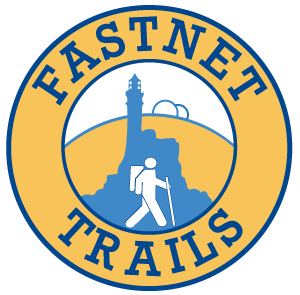Derreenard Loop Walk
| Type of Route | Arrows | Distance | Grading | Estimated Time |
| Loop Walk | Purple | 12 km | Easy | 3 – 4 hours |
In order to follow Derreenard Loop Walk you have to head back out on the N71 and crossing with extreme care head east. Leaving the N71 two standing stones, known as “The Galauns”, can be seen 1 ½ miles away on the horizon in Foherlagh. The same distance away is a Cairn (a large circular mound of stones) at Skeagh. At Lissaclarig, 800m off the road, is a Ring Fort complete with circular Moat and Souterrain. A bronze arrow head found here in the 1940’s is now in the Fitzgerald’s Park Museum, Cork. Continuing, the walker passes the old Derreenard National School closed since the 1960’s, now in private hands. There are panoramic views from here of Roaring Water Bay and Ballydehob, with Mount Kidd (800 ft) in the background.
Further on is Derreenard Bridge which featured in the War of Independence when it was booby trapped by the military and made safe by two local volunteers. Corravoley has a former school (closed in the 1950’s) and teacher’s residence, an example of the way things were. These are now privately owned. Some remains of Corravoley Church of Ireland (1830) can also be seen.
Take Note
🥾This walk is graded as Easy
🐕🦺Dogs must be kept on a lead at all times.
Walk Guide
Derreenard Loop Walk starts at the Trailhead (1), located in a small car park by the river bridge, just opposite Kilcoe Church. Cross the N71 (with extreme care) and enter a side road signposted to Prohoness.
Follow this busy minor road for about one kilometre and look out for a turning to the LEFT (2) on a straight flat piece of road. Follow this much quieter road and quite soon you cross a stream just after some farm buildings.
The road starts to climb gently, passing some side roads which you ignore (3), and eventually levels out and passes through some wild country with scrub and bits of forestry. After about 3km the road sweeps left, you pass a stonewalled entrance to a house on the right and then a road junction. There is a farm track going off left but you go STRAIGHT ON and past a farm, then after less than a kilometre the road takes a bend to the right and you reach a junction (5) as the road swings to the right.
After only 200m you reach a junction and turn LEFT onto a small road. This winds its way through fields and a farm but stick to the road all the way. After about 1km (15mins) you reach a T junction (7).
There is an optional detour to the right indicated on a sign. (You can go right to see Dereenard Bridge which has historical interest. Then return to the junction.)
From the junction (7) you should head south for 0.5km dropping gently downhill, over a stream and back uphill to a series of three junctions (8). The 1st is a branch to the right which you can ignore and the 2nd is a branch left which you also ignore. Almost immediately the road FORKS and you should go to the RIGHT.
Now follow the road as it winds through Lisheenacrehig townland.
Soon you reach a farm with buildings both sides of the road – keep going and you emerge into open country again, past a bungalow on the left, then reach a road junction (9) where you must keep LEFT.

This next section is about 1.5km and the road rises steadily and levels out until finally you will see the old Church of Ireland burial ground on the right. Take a few minutes to explore and then proceed south, past the sawmill, to reach the N71 (10)
Cross over the main road with great care and follow the quiet side road past a few houses until you reach a cross roads (11) just after a large house on the left. Turn LEFT and quite soon you come to the Pre-famine church remains and old burial ground. Take a few minutes to rest and enjoy this unique place.
Leaving the church behind follow the road downhill through an old farm and round a few bends until you descend steeply to a cross roads (12) near a bridge over the gurgling stream. The route back to the Trailhead goes sharp LEFT up the hill before the bridge. If you have time take a short detour downstream to explore the beautiful Roaringwater Quay built to enable copper ore to be exported from the nearby mine workings.
From the cross roads, you ascend past a boat yard on your left to reach the newer Kilcoe Church and Trailhead in less than ten minutes
Kilcoe Church

As you proceed along this road you will observe Mount Kidd (800ft) on your right and looking left Mount Gabriel (1340ft) to the west. This particular road was used frequently by the military in the era preceding the Treaty of 1921 and there are some stories regarding ambushes of soldiers and trucks. Derrinnard Bridge, to the north of this walk was the location of one of these incidents. (Look out for sign directing you to this bridge at a T-junction.)
In 1830, Kilcoe Church of Ireland parish church was built here in the townland of Currovolley by means of a grant of £650 from the Board of First Fruits. (just north of the Sawmill). The church was of a simple design and it was constructed from cheap local materials. The church was closed in 1991 and it was demolished in 1994. Today only its outline remains at this site, however its furniture it still in use in other churches locally and its bell found a new home in Dodoma Cathedral, Tanzania, Africa.
Kilcoe Parish rectory was built nearby. During the Great Famine of 1845-52 the then rector, the Rev. James Freke, operated a soup kitchen from that site. A parochial school was also situated a short distance from the church. This closed in 1951. Today the former school and rectory are both private residences.
The graveyard that surrounds the former church contains about thirty headstones. These mainly date from the 20th century, with a few dating from the 1800s. The oldest headstone dates from 1856 and is dedicated to Miss Arabella Spring. She was the daughter of the Rev. Edward Spring who was rector of Kilcoe and Cape Clear from 1852 to 1864. A survey of the headstones in this graveyard is available online at www.graveyards.skibbheritage.com
The Pre-Famine Church

This was the late Penal chapel (late 1700’s or early 1800’s) on what was then the main road from Skibbereen to Ballydehob. It was a very plain T-shaped church.
All that remains now is a single gable after a very bad storm hit the structure around 1890. The church wall is a veritable rock garden with spleenwort, navelworth, stonecrop vetches and hard ferns.
The area adjoining the church was a busy village with plenty employment around Roaring Water pier nearby. The two-storey building just below the church was the boys school. All that remains of the girls school is a wall across the road above the church which is completely overgrow. The two-storey building across the road was a house with a shop adjoining and there was also a carpenter’s workshop nearby.
Roaring Water Quay

The small Roaring Water river, for which the huge bay is named, rises 6 miles north on the slopes of Mt. Kid. James O’ Sullivan, who lived in the big house at Roaring Water was born in 1758 and died between 1837 and 1839. He was described as a gentleman, a corn merchant and one-time smuggler. He erected tuck mills (to treat cloth), corn stores and quays at Roaring Water. He owned two boats to transport corn & had stores in Cork Harbour also. The Roaring Water area was thus a hive of industry employing up to 150 people at one time. The last corn mill was just opposite the entrance to Whooley’s boat yard and the remains of a man-made weir can still be seen there.
Smuggling was very common as travel was almost impossible west of Skibbereen which made conditions difficult for the constabulary. Commodities such as brandy, tea and tobacco were regularly smuggled but tobacco was the most profitable. Offenders, when caught, were routinely transported to Van Diemen’s Land.
Copper mining was carried out between 1844 and 1872, but had little success despite the involvement of experienced miners from Cornwall. A map of 1863 shows five shafts, mine stores, a warehouse, a mine office and miner’s cottage. The mine office was located on the site of what now is Roaring Water House.

